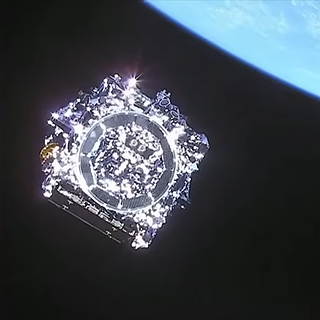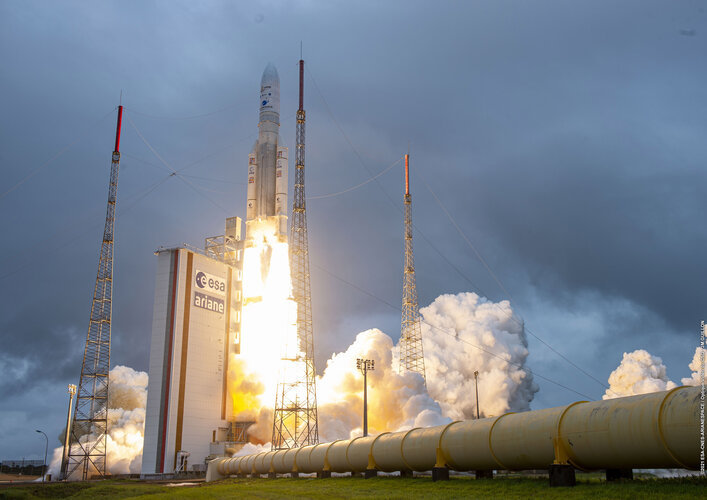
Copernical Team
Monday, 27 December 2021 08:52
NASA, private space industry may reach new heights in 2022
Orlando FL (UPI) Dec 27, 2021
 Space exploration may shatter records in 2022 with the launch of the most powerful rocket ever in a flight beyond the moon, a space telescope that will peer into the dawn of the universe and groundbreaking science on Mars.
The New Year also may see SpaceX's deep space Starship rocket fly above the atmosphere, expansion of space tourism and new rocket launches from companies such as United
Space exploration may shatter records in 2022 with the launch of the most powerful rocket ever in a flight beyond the moon, a space telescope that will peer into the dawn of the universe and groundbreaking science on Mars.
The New Year also may see SpaceX's deep space Starship rocket fly above the atmosphere, expansion of space tourism and new rocket launches from companies such as United
 Space exploration may shatter records in 2022 with the launch of the most powerful rocket ever in a flight beyond the moon, a space telescope that will peer into the dawn of the universe and groundbreaking science on Mars.
The New Year also may see SpaceX's deep space Starship rocket fly above the atmosphere, expansion of space tourism and new rocket launches from companies such as United
Space exploration may shatter records in 2022 with the launch of the most powerful rocket ever in a flight beyond the moon, a space telescope that will peer into the dawn of the universe and groundbreaking science on Mars.
The New Year also may see SpaceX's deep space Starship rocket fly above the atmosphere, expansion of space tourism and new rocket launches from companies such as United
Published in
News
Tagged under
Monday, 27 December 2021 08:52
Ball Aerospace-built optics and mirror system launched aboard Webb Telescope
Broomfield CO (SPX) Dec 27, 2021
 Ball Aerospace is celebrating the launch of NASA's James Webb Space Telescope (Webb) from French Guiana. The Colorado-based company designed and built the advanced optical technology and lightweight mirror system that will enable Webb to detect light from the first stars and galaxies.
"It is truly an honor to be such an integral part of the next great space observatory," said Dr. Makenzie
Ball Aerospace is celebrating the launch of NASA's James Webb Space Telescope (Webb) from French Guiana. The Colorado-based company designed and built the advanced optical technology and lightweight mirror system that will enable Webb to detect light from the first stars and galaxies.
"It is truly an honor to be such an integral part of the next great space observatory," said Dr. Makenzie
 Ball Aerospace is celebrating the launch of NASA's James Webb Space Telescope (Webb) from French Guiana. The Colorado-based company designed and built the advanced optical technology and lightweight mirror system that will enable Webb to detect light from the first stars and galaxies.
"It is truly an honor to be such an integral part of the next great space observatory," said Dr. Makenzie
Ball Aerospace is celebrating the launch of NASA's James Webb Space Telescope (Webb) from French Guiana. The Colorado-based company designed and built the advanced optical technology and lightweight mirror system that will enable Webb to detect light from the first stars and galaxies.
"It is truly an honor to be such an integral part of the next great space observatory," said Dr. Makenzie
Published in
News
Tagged under
Monday, 27 December 2021 08:52
L3Harris Completes Final US Missile Defense Agency Satellite Design Milestone
Melbourne FL (SPX) Dec 21, 2021
 L3Harris Technologies has completed the final major design milestone on the U.S. Missile Defense Agency's (MDA) Hypersonic and Ballistic Tracking Space Sensor (HBTSS) program Phase IIb On-orbit Prototype Demonstration and has already begun building the demonstration satellite.
Completing the CDR is the final design milestone ensuring performance, cost and schedule requirements can be met b
L3Harris Technologies has completed the final major design milestone on the U.S. Missile Defense Agency's (MDA) Hypersonic and Ballistic Tracking Space Sensor (HBTSS) program Phase IIb On-orbit Prototype Demonstration and has already begun building the demonstration satellite.
Completing the CDR is the final design milestone ensuring performance, cost and schedule requirements can be met b
Published in
News
Tagged under
Monday, 27 December 2021 08:52
RUAG technology helped launch Webb into space
Zurich, Switzerland (SPX) Dec 27, 2021
 Technology from RUAG Space protected the James Webb Space Telescope during launch and flight into space. A payload adapter placed the observatory into orbit. The launch happened on December 25.
The James Webb Space Telescope - or short "Webb" - is the largest and most powerful space telescope ever built. The successor of the Hubble space telescope will be able to peer into the oldest, most
Technology from RUAG Space protected the James Webb Space Telescope during launch and flight into space. A payload adapter placed the observatory into orbit. The launch happened on December 25.
The James Webb Space Telescope - or short "Webb" - is the largest and most powerful space telescope ever built. The successor of the Hubble space telescope will be able to peer into the oldest, most
 Technology from RUAG Space protected the James Webb Space Telescope during launch and flight into space. A payload adapter placed the observatory into orbit. The launch happened on December 25.
The James Webb Space Telescope - or short "Webb" - is the largest and most powerful space telescope ever built. The successor of the Hubble space telescope will be able to peer into the oldest, most
Technology from RUAG Space protected the James Webb Space Telescope during launch and flight into space. A payload adapter placed the observatory into orbit. The launch happened on December 25.
The James Webb Space Telescope - or short "Webb" - is the largest and most powerful space telescope ever built. The successor of the Hubble space telescope will be able to peer into the oldest, most
Published in
News
Tagged under
Monday, 27 December 2021 08:52
MIT engineers test an idea for a new hovering Lunar rover
Boston MA (SPX) Dec 27, 2021
 Aerospace engineers at MIT are testing a new concept for a hovering rover that levitates by harnessing the moon's natural charge.
Because they lack an atmosphere, the moon and other airless bodies such as asteroids can build up an electric field through direct exposure to the sun and surrounding plasma. On the moon, this surface charge is strong enough to levitate dust more than 1 meter ab
Aerospace engineers at MIT are testing a new concept for a hovering rover that levitates by harnessing the moon's natural charge.
Because they lack an atmosphere, the moon and other airless bodies such as asteroids can build up an electric field through direct exposure to the sun and surrounding plasma. On the moon, this surface charge is strong enough to levitate dust more than 1 meter ab
 Aerospace engineers at MIT are testing a new concept for a hovering rover that levitates by harnessing the moon's natural charge.
Because they lack an atmosphere, the moon and other airless bodies such as asteroids can build up an electric field through direct exposure to the sun and surrounding plasma. On the moon, this surface charge is strong enough to levitate dust more than 1 meter ab
Aerospace engineers at MIT are testing a new concept for a hovering rover that levitates by harnessing the moon's natural charge.
Because they lack an atmosphere, the moon and other airless bodies such as asteroids can build up an electric field through direct exposure to the sun and surrounding plasma. On the moon, this surface charge is strong enough to levitate dust more than 1 meter ab
Published in
News
Tagged under
Saturday, 25 December 2021 19:31
James Webb telescope sets off on million-mile voyage
Kourou (AFP) Dec 25, 2021
 The world's most powerful space telescope on Saturday blasted off into orbit, headed to an outpost 1.5 million kilometres (930,000 miles) from Earth, after several delays caused by technical hitches.
The James Webb Space Telescope, some three decades and billions of dollars in the making, left Earth enclosed in its Ariane 5 rocket from Kourou Space Centre in French Guiana.
"What an amazi
The world's most powerful space telescope on Saturday blasted off into orbit, headed to an outpost 1.5 million kilometres (930,000 miles) from Earth, after several delays caused by technical hitches.
The James Webb Space Telescope, some three decades and billions of dollars in the making, left Earth enclosed in its Ariane 5 rocket from Kourou Space Centre in French Guiana.
"What an amazi
 The world's most powerful space telescope on Saturday blasted off into orbit, headed to an outpost 1.5 million kilometres (930,000 miles) from Earth, after several delays caused by technical hitches.
The James Webb Space Telescope, some three decades and billions of dollars in the making, left Earth enclosed in its Ariane 5 rocket from Kourou Space Centre in French Guiana.
"What an amazi
The world's most powerful space telescope on Saturday blasted off into orbit, headed to an outpost 1.5 million kilometres (930,000 miles) from Earth, after several delays caused by technical hitches.
The James Webb Space Telescope, some three decades and billions of dollars in the making, left Earth enclosed in its Ariane 5 rocket from Kourou Space Centre in French Guiana.
"What an amazi
Published in
News
Tagged under
Saturday, 25 December 2021 12:10
NASA's Webb Telescope Launches to See First Galaxies, Distant Worlds
 NASA’s James Webb Space Telescope launched at 7:20 a.m. EST Saturday on an Ariane 5 rocket from Europe’s Spaceport.
NASA’s James Webb Space Telescope launched at 7:20 a.m. EST Saturday on an Ariane 5 rocket from Europe’s Spaceport.
Published in
News
Tagged under
Saturday, 25 December 2021 11:57
Liftoff in images: Webb on Ariane 5

The James Webb Space Telescope lifted off on an Ariane 5 rocket from Europe’s Spaceport in French Guiana, at 13:20 CET on 25 December on its exciting mission to unlock the secrets of the Universe.
Published in
News
Tagged under
Saturday, 25 December 2021 12:00
Webb liftoff on Ariane 5 to unlock secrets of the Universe

The James Webb Space Telescope lifted off on an Ariane 5 rocket from Europe’s Spaceport in French Guiana, at 13:20 CET on 25 December on its exciting mission to unlock the secrets of the Universe.
Published in
News
Tagged under
Saturday, 25 December 2021 12:30
Liftoff replay: Webb on Ariane 5
 Video:
00:01:09
Video:
00:01:09
The James Webb Space Telescope lifted off on an Ariane 5 rocket from Europe’s Spaceport in French Guiana, at 13:20 CET on 25 December on its exciting mission to unlock the secrets of the Universe.
Published in
News
Tagged under
